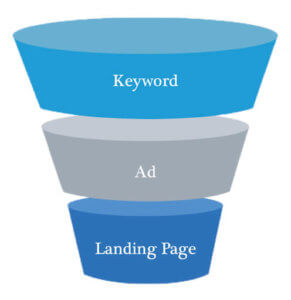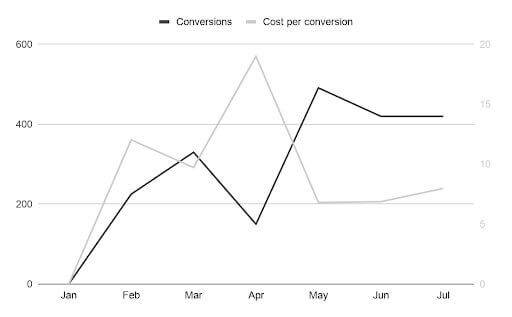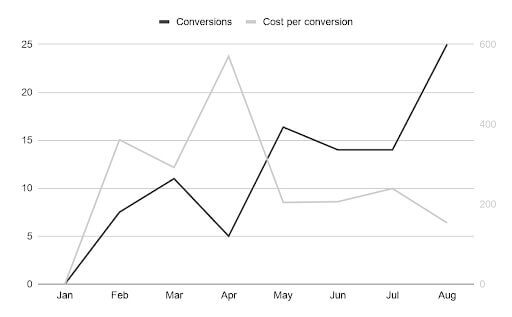The following is from the presentation above at our Digital Marketing Breakfast series in September 2019 by Ryan Jones. It’s been edited for clarity.
The first thing you should know about me is I’m a bit of a car nut. I’ve travelled across the world to watch 24 hrs of racing and enjoyed it so much I forgot to take a nap during the race. I guess you could say it’s more than a casual interest for me. So when asked to explain my approach to ads optimisation and thinking a bit on how to present, it dawned on me that performance tuning a car and optimising an ads account are practically the same. So in this presentation, I’ll explain how I’m going to put the ‘engine’ into Search Engine Marketing (SEM).
Just stay with me for a sec. Let’s say we are looking to improve the performance of this car. Where do we start?
When we’re performance tuning a car, we get it in the shop, we get it up on blocks, and we want to maximize the performance and the output of the engine, and every part to get as much speed as possible. The majority of our time will be spent maximising the efficiency of the drive chain. That is everything that moves between hitting the accelerator and taking off. The drive chain is made up of
- the engine,
- driveshaft, and
- wheels.
They cost the most money to fix when they go wrong, and they have the greatest impact on our performance when we’re getting it up and if you remove any of these parts you’ll be walking home.
When we are optimising our ads account we are looking to maximise the output of that drive chain:
- keywords,
- ads, and
- landing pages.
You take away any of these three things and everything stops. So to improve the performance of an account, I spend the majority of my time working on these three parts to drive more power from the keyword to the landing page.

It’s important to note that much like the drive chain of a car, our keywords, ads and landing pages need to work together efficiently. You can’t work on these important parts in isolation.
I’ll admit I have spent a lot of time working each part separately, adjusting the ads or playing with the keywords and I could never maximise the performance because when it comes down to it, Google Ads are a funnel with search results going in the top, and leads coming out the bottom. Each step needs to build off the one before it to maximise the efficiency of our drive chain.
Adwords Metrics that Motor
How do we know what is wrong with our car’s performance? We put it up on the dyno and check the output.
The same for our SEM. How do we know if our funnel is leaking? We put it up on a ‘dyno’ and check the metrics, (the click-through rate and conversion rate). These two metrics measure the quality of the relationship between keyword, ad and landing page. They’ll tell us whether our account is a lemon or a Lamborghini.
Click-Through Rate
CTR is particularly valuable because it lets us know how many people click through, after seeing our ads. If this is low it means either the keyword doesn’t match our business or the ad shown isn’t relevant to the keyword, meaning the connection between our ad and our keyword isn’t telling the customer we have what they need. Google also monitors CTR closely because it’s used in determining ad quality score. Google uses Quality score in the bid auction to determine the cost per click. The higher your quality score, the lower the cost you’re going to pay for a click compared to your competitor. Therefore the higher your click-through rate, the better Google thinks your ad is at driving your click and giving the customer what they need. In other words, the higher your click-through rate the more efficient your account is running, and the better ‘fuel economy’ you’ll get.
Conversion Rate
The conversion rate reveals a similar measure of the relationship between your ad and your landing page, indicating whether our website can deliver on the promise of the ad. The higher our conversion rate the less each lead will cost us because our ads and landing pages are working efficiently in driving high-quality traffic, that’s looking to interact with our business.
There are other metrics that I monitor closely, such as the conversions, cost per conversion and cost per click (CPC) because this is what the client cares about. These metrics reveal the dollars and cents and indicate what value is achieved from our activities.
The Engine – Keywords
Time to get our hands dirty.
Build ad groups around keywords
Much like an engine driving power to the wheels, our keywords deliver power through our ads to the website, so we need to target high octane searches that will deliver conversions for our business. The first step is to always base your ad group structure around keyword clusters. This way, the ads can be more specific, yet still relevant to all searches triggered. The more specific the ad the better chance of a click. If you are looking for this car, are you more likely to click on an ad that says buy a Ford… or buy a Red V8 Mustang GT?
Look for long-tail keywords
The next step is to look beyond our broad keywords to target long-tail search terms. These are keywords with 2-4 terms, and they will improve the efficiency of our targeting. To sell this car we could target the word Ford, but why not target ‘red ford’, or ‘high-performance red ford’. This helps build more relevant ads but also filters out low-value searches. In that way, we don’t deliver ads to people looking for ford falcons when we don’t sell them anymore.
Negative keywords
Now, no matter how deliberate you are in your keyword strategy, some of your ads will leak out and end up displaying for irrelevant searches. This is why we have a negative keyword list. We use it like a performance tune on our engine. Do not forget to add any and all negative keywords you need, to ensure you don’t waste money on irrelevant searches. This isn’t a ‘set and forget’ task – you need to be visiting the search terms report regularly to ensure you haven’t missed anything.
Another tool
I also want to give you another spanner for your toolbox:
Keywords Everywhere is a very cheap plugin that turns your google results pages into a keyword mining tool, giving you ideas for long tails, similar terms and will also tell you how much competition there is on any search. So check it out.
The Drive Shaft – Ads
For those of you that don’t know, this is what a drive shaft looks like. All it does is turn with the engine, transferring power to the wheels. Our ads operate much the same way, transferring customers from the search page to our website. It’s pretty straight forward but I still have some quick tips to build better ads.
Quick Tips to Build Better Google Ads
- Insert keywords – If our overall goal is to make our ads relevant to our keywords then including the keywords in our ads is the fastest way to do it. That way the customer will see exactly what they’re searching for and won’t need to look any further.
- Variation – Google is great at rotating through ads so adding as much variation to the copy in our time constraints will ensure the best combination rises to the top. I always recommend having at least three ads per ad group.
- Extensions – just Imagine for a second you are in a race car, it’s the last lap and you’ve got the lead, but the guy filling your mirrors is in a faster car. You are approaching the last corner and really don’t want to let this guy beat you. So you make your car as wide as possible through the turn so he can’t get past you. Extensions are used in exactly the same way. They take up as much space as possible on the search page making our ads stand out. But remember, relevance is key and don’t forget our goal is to maximise the relationship between keyword and ad, so the extensions you use, need to be relevant to the search.
The Wheels – Landing Pages
Now it’s time to throw some big shiny wheels on our car/account.
Sometimes we get so deep into optimising our campaigns that we forget that we are driving traffic to our website.
Choose the most relevant page
Having relevant landing pages is the biggest factor in getting a conversion so make sure you send your customer to the most relevant page. Don’t expect them to reward you for dropping them on the homepage and hoping they find their own way.
Create a page if needed
If you don’t have a relevant page, make one. Just duplicate the nearest thing and chop it to the specs you need.
Link to every relevant page
Finally, you should be making it as quick and easy for your prospects to find more information and convert when they’re ready. So be sure to add internal links to your landing page to any relevant information.
Regular calls to action
Add regular call outs to your conversion actions, be it enquire, call or purchase.
More keyword insertion
I want to reiterate how valuable it is to use keyword insertion to maximize the connection throughout the ‘drive chain’ of your ad campaign. If you can find a very selective keyword with a relevant ad that includes exactly what your prospect wants and then mirror that with a landing page by reinserting the keyword either in the title or the text, the customer can see the ad as yes, that’s what they want, then they go to your web page and say yes, that’s what they want. And that is the best and the simplest way to tick those boxes in the customer’s mind to let them know that you know exactly what they want and you can provide it to them.
Reduce Drag – Google Ad Account Settings
Now that we’ve squeezed every drop of power out of our drive chain, we can put everything back together. From this point on, any performance upgrades are designed for two things, to reduce drag or save weight.
And I mean this for both a car and ads account. Tune-up your account settings to save your budget for times, locations and devices that are proven valuable to your business. Cutting the rest will drop a heap of excess weight from your account.
This maximizes the use of our budget and extends how many clicks we can get in a day because at the end of the day, all of this costs money and we don’t want to be sending money down the toilet.
Case Study: Sydney Porsche
To finish up, I’d like to pop the hood on an account we picked up a few months ago. Now the data is real, but for confidentiality purposes, everything else has been changed, only in my dreams am I running ads for a Porsche dealership.
Previous Performance
Looking at the results and the problems jump out immediately. Cost per click is the highest I’ve ever seen and up to $500 an enquiry is just not viable for this business. You can see from our two KPIs that there are probably issues in the drive chain of this account.
And that’s exactly what we found. They were using almost exclusively broad keywords and very few negative keywords which meant they were showing ads to people looking to buy Porsches in Singapore despite extremely tight location restrictions. On top of this, the ads were bland and the Landing pages that were chosen often didn’t make sense.

| CTR | Avg CPC | Spend | Conversions | Cost Per Conversion | Conversion Rate | |
| 6 month Avg | 5.13% | $9.13 | $3,500 | 11 | $306.149 | 2.98% |
The Tune-Up
So we took the account and spent the time tuning it up. Starting with the keywords. We reorganised them into closely related ad groups and replaced the broad keywords with longer tail variants. Importantly many of the keywords added were tied to locations such as Sydney or North Shore which meant we could loosen the location settings to target more people that were interested in buying a Porsche in Sydney.
We also updated the ads with a combination of keyword insertions, call to actions and the usual qualities statements that set our client apart. Extensions were also added liberally to block out the competition.
We then moved away from our account to check out the website, finding more relevant landing pages for each of our campaigns. We are now in the process of building and testing some custom landing pages for ad groups with the poorest conversion rates, looking to further boost performance.
Finally, we trimmed out our irrelevant traffic, noticing little to no conversions being recorded on the weekends or from tablet and mobile devices so both got cut down. We also changed our bid strategies to “maximise conversions” to be more selective in what we target because the competition is so high for this account. Cost per click will be an ongoing problem so we need to be maximising the opportunity for conversions.
The Results
And here are the next month’s results. Personally, I think they speak for themselves.

| CTR | Avg CPC | Spend | Conversions | Cost Per Conversion | Conversion Rate | |
| Next Month | 7.75% | $8.55 | $3,829.5 | 26 | $153.18 | 5.58% |
| 6 month Avg | 5.13% | $9.13 | $3,500 | 11 | $306.149 | 2.98% |
Thank you.